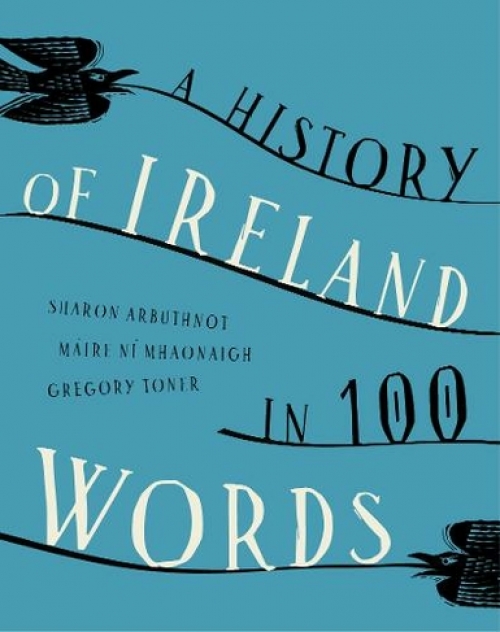A History of Ireland in 100 Words

Luke Callinan reviews A History of Ireland in 100 Words by Sharon Arbuthnot, Máire Ní Mhaonaigh and Gregory Toner, Royal Irish Academy, 320 pp, €19.99, ISBN: 9781911479185.
“Ní hí an teanga do chuaidh ó chion
acht an dream dár dhual a dídion
(mon-uar) dár bhéigin a ndán
sa nduan do thréigin go tiomlán”
“It is not the language which has come into
disesteem but those who should protect it,
they who have been (alas!) obliged to
abandon their poems and verses completely.”
- 17th Century poem by Diarmuid Mac Muireadhaigh addressed to Górdún Ó Néill, a captain in the army of King James II.
Ogham inscriptions provide the earliest concrete evidence of the Irish language, dating as far back as the 4th century, while the majority of extant examples can be traced to the following 5th and 6thcenturies. This primitive form of written Irish evolved and developed in to what would become the most extensive surviving literature in early modern medieval Europe. While the depth and richness of this literature has been examined and understood by a section of Irish academia, its intertexuality as well as the wider cultural and social hegemony that fused it and gave it real meaning has been largely lost on those who currently inhabit the island(s) of Ireland.
This loss of collective social and cultural values, memories and ways of thinking is particularly regrettable. It didn’t take place overnight nor did it happen in a cultural or political vacuum: it is the logical outcome of a coherent, brutal and multifarious colonisation process that successfully replaced Irish with English as the primary medium of communication for the bulk of the country. This process has been examined thoroughly by well-known writer and publisher Tomás Mac Síomóin in his books The Broken Harp and The Gael Becomes Irish.
An encouraging trend has emerged in Irish language literature in which Irish language texts are being reproduced, reimagined and reconstructed by modern scholars. Examples of these productions include Tuatha Dé Danann by Diarmuid Johnson, An Tromdhámh by Feargal Ó Béarra and Darach Ó Scolaí’s Táin Bó Cuailnge. These, and others like them, present today’s reader with some of the most important figures, events and narratives from our literary tradition in the medium of modern Irish.
A History of Ireland in 100 Words is a valuable contribution to this work. While the authors clarify that the publication is not an attempt to comprehensively detail the course of Irish history, it serves to highlight the collated lexicon of Old and Middle Irish based on materials from the period c.700-1700. As the authors explain, its purpose is to provide “insights into moments of life that may be otherwise absent from the history books”; and in this it certainly succeeds.
We are presented with lively accounts of 100 words in the Irish language from this period, some of which have even survived in Hiberno-English language registers such as ‘Taoiseach’ (the term for Ireland’s ‘Prime Minister’), ‘Leipreachán’, ‘Bóithrín’ (literally a small cow-path but used to describe a narrow, frequently unpaved, road in rural parts of Ireland), ‘Bróg’ (meaning ‘shoe’ but used contemporarily to describe a person’s accent) and ‘Punt’ (the Irish currency until 2002).
We learn that the word for poet in Irish, ‘file’, is related to the verb ‘to see’, demonstrating a perceived prophetic capacity. This applies to great art up to this day as an alternative way of understanding the world to science and philosophy.
Language and colonisation
Discussion of the word ‘Gall’, understood by many today as ‘foreigner’ but with a much deeper and complex history, puts a spotlight on the 12th century King of Leinster, Diarmaid na nGall, who sought the military assistance of England’s King Henry II to regain his kingdom, sparking a chain of events that would result in the Anglo-Norman invasion of 1169.
While the earliest documented form of political authority in Ireland was kingship, with a king (‘rí’) for each kingdom (‘tuath’), by the 8th century this power structure was being surpassed by the emergence of leaders controlling larger territories. The title given to these was ‘Taoiseach’, originally meaning ‘first’ but clearly having evolved at an early stage to indicate ‘leader’. This survives today in the term for Ireland’s highest government office holder, ‘An Taoiseach’. It is worth mentioning evidence of women in the role of ‘Taoiseach’ as far back as the 8th century, unlike today’s office, which has never been held by a woman.
The 15th century curse ‘úir aineoil tarat’ (‘may foreign soil be over you’) implies negative connotations for foreign burials and vividly reinforces the deep connection people had to land and territory had in Gaelic Ireland. It reminded me of Big Bill Neidjie’s words, an elder of the Kakadu people in northern Australia: “I feel with my body, with my blood. Feeling all these trees, all this country. When this wind blow you can feel it. Same for country… you feel it, you can look, but feeling… that make you.”
In general, of course, the wisdom contained in Irish medieval literature reflects a symbiotic land-animal-human relationship that generated respect and fear in equal measure. Use of the term ‘mac tíre’ (‘son of the land’) for wolf was employed to avoid summoning the animal by speaking his actual name, ‘faol’, but has come to be the most common word for ‘wolf’ in modern Irish. Ireland’s wild wolves of course became extinct in the late 18th century.
Edmund Spenser, an English colonizer and poet of the late 16th century Tudor re-conquest period in Ireland, understood the central importance of language in the colonising process. He wrote that “words are the image of the mynde, the mynde must needs be affected with the words: So that the speech beinge Irishe, the harte must needs be Irishe, for out of aboundance of the harte the tongue speaketh.” If Irish people could be coerced in to adopting the English language, they would come to accept a world view framed by that language, one that would re-define how they see themselves and their place in the world.
Kenyan academic Ngũgĩ wa Thiong'o has described languages as natural hard-drives, positing that the loss of that hard drive invariably causes loss of the memories and knowledge, information, thoughts and thought-processes which have been carried by that language for generations.
Collective recovery of our Irish language hard-drive is an essential component in the de-colonisation of Ireland and A History of Ireland in 100 Words, as well as the invaluable work of all those involved with the Electronic Dictionary of the Irish Language project more broadly, certainly provides some of the tools to help do that successfully.

Luke Callinan
Luke Callinan is a Left Republican from south County Roscommon, Ireland. His main interests are Irish literature and history.
